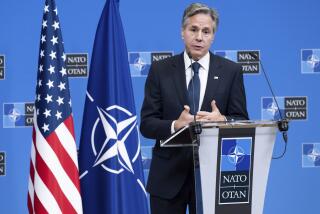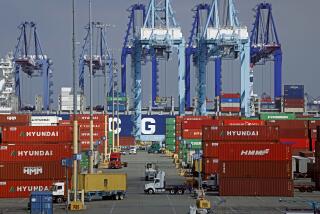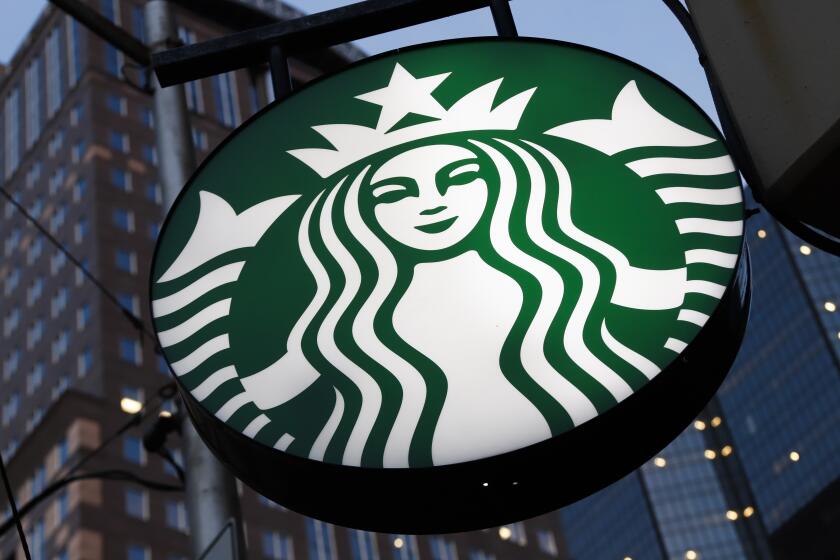THE ATLANTIC RIM : Despite ‘Pacific Mania,’ Some Firms Still See Europe as Their Best Hope
At the Cool-A-Coo ice cream company in Whittier, owner Leo Politis was looking for a new way to boost business.
He toyed with exporting his round, Cool-A-Coo ice cream sandwiches to Japan. But confusing regulations blocked the way. “It’s very difficult to sell in Asia, especially Japan,” concluded the Greek native, 59.
Then he tried a different tack: Politis turned away from the Pacific and looked across the Atlantic to 320 million potential ice cream eaters in Western Europe.
It paid off. In February, the first of 2 million Cool-A-Coos were trucked to Long Beach, hauled to Houston by rail and loaded on a boat for Athens.
“That’s the way we’re going to do it with England, and that’s the way we’re going to do it with Holland,” predicted the ice cream vendor, who came to America as a dishwasher 38 years ago.
In a day when commentators herald the dawn of a Pacific century, Politis’ success points to a reality that often is overlooked: Europe--not Asia--endures as America’s closest business and economic partner in important ways.
Now, after years of “Euro-pessimism” brought on by chronic unemployment and sluggish growth, that reality is gaining new attention.
U.S. business executives and policy-makers are focusing new interest across the Atlantic as West Germany, France, England and their neighbors try to establish greater economic unity--and power--starting in 1992.
The new concern with Europe even has reached California, where dreams of Pacific riches loom large among traders.
“Many say we’re on the edge of the Pacific Rim, but actually we’re at the center of a global economy,” declares Gregory Mignano, executive director of the state’s World Trade Commission.
Nobody is dismissing Asia’s prodigious growth rates or the vast volumes of trade that flow through the Pacific. In terms of size alone, Japan’s towering economic and financial might has no equal among individual European nations. U.S.-Asian business ties seem certain to grow even stronger.
It’s just that some scholars believe a sort of “Pacific mania” took hold in the United States in recent years, creating a simple-minded and distorted view of the complex global economy.
“The exclusive focus of our attention on the Pacific Basin--as if the rest of the world doesn’t matter--I simply don’t accept it,” said Jose de la Torre, a professor of international business at UCLA.
De la Torre and others point out that the Pacific region is really a hodgepodge of economies sprawled throughout North and South America as well as Asia. Sweeping references to it have little meaning.
Western Europe, by contrast, represents a concentration of some of the most advanced economies and highest living standards in the world. Combined, their economic muscle rivals that of the United States.
“France has been falling for 150 years--and it’s still richer than Japan,” said Stephen S. Cohen, director of the Berkeley Roundtable on the International Economy.
He continued: “The Pacific Rim is a concept that only makes sense to geologists. What, in God’s name, do Chile, Japan and Canada have in common? I can’t think of anything.”
Few countries bordering the Pacific are in the top tier of global consumer markets, according to a recent report by the Coopers & Lybrand accounting firm. Even such Pacific success stories as Singapore, Hong Kong and South Korea face potential instability in the future.
For purposes of business planning, “Strategically, there is no Pacific Rim,” the accounting firm concluded.
By contrast, few would doubt that Western Europe and the United States share important cultural and historic ground. The Europeans were the first foreign investors in this country, financing railroads, buying real estate and otherwise infusing capital into America’s fledgling economy.
The legacy endures: Europe’s stake in American industry dwarfs Asia’s. England remains the major foreign investor in U.S. industry by far, with assets of $75 billion, according to 1987 Commerce Department figures. Japan, with less than half that amount, ranked third, behind the Netherlands.
“The Japanese are the most feared competitors, but the Europeans are the people who might buy your company,” maintained William Burnside, a vice president with the Boston Consulting Group in Los Angeles.
Thousands of American workers know what he means. Since the start of last year, Europeans have moved to purchase 319 U.S. firms worth a total of $45.1 billion, according to IDD Information Services.
For all the attention given to Japan’s U.S. investments, Japan and its Asian neighbors agreed to buy just 55 companies over the same period, worth just a small fraction of Europe’s U.S. haul.
“If you look at a list of the big companies that own things in the United States, it’s still British and Dutch and German. It’s not Japanese yet,” said Stephen Levy, director of the Center for Continuing Study of the California Economy.
And the list is growing. A sample from recent shopping expeditions: Pillsbury, General Electric’s RCA television division, Manpower personnel services, Farmers Group Insurance, Triangle Industries, MacMillan publishing company and SmithKline Beckman pharmaceuticals.
Yet such investments are only a part of the business bonds between America and Europe. The Atlantic endures as a crucially important trading route, not just for America’s East Coast but for the West, as well.
A 1988 study by the California State World Trade Commission found that official U.S. trade figures sharply underestimated Europe’s importance as a market for California exports.
Far East Less Important
“We’re hooked into Western Europe a lot more than most people assumed,” said Jock O’Connell, a consultant who worked on the report. “The discovery of those new statistics caused us to totally reevaluate the pattern of overseas markets for California goods and services.”
The state researchers concluded that nearly one-third of California exports are shipped across the Atlantic (compared to the 23% reported by the U.S. Census Bureau.) At the same time, they reported that the Far East is less important than had been thought, with under half the state’s exports going to Asia, contrary to the 64.5% reported by the government.
What are the California goods sold in Europe? A whole catalogue of products--ranging from chemicals to cotton, digital instruments to dried fruits, metal scrap to missiles--makes the 6,000-mile California-Europe journey.
A Chatsworth company that produces undersea electrical connectors recently sold $350,000 worth to a Scottish firm that supplies North Sea oil drillers. The California company, Kintec, has a $2.3-million deal pending with a Norwegian customer--a bonanza that would double its annual revenues.
“There could be some good opportunities in the Pacific Rim, but we’ve been focused on Europe, primarily in the North Sea,” explained Dwight Ham, Kintec’s vice president.
‘Best Ice Cream in Greece’
Similarly, Leo Politis--wishing to boost ice cream sales in the slower winter months--found his answer in the Mediterranean climate of Greece. Last fall, he signed a $400,000 deal with a Greek distributor. The Whittier-made treats, he said with some pride, have been selling even faster than his Athens buyers expected.
“I knew it was going to be the best ice cream in Greece,” Politis added in a matter-of-fact tone. “They have lousy ice cream.”
A new study by the trade commission found that 28% of California exports, worth $7.6 billion, went to California’s major European trading partners in 1987, a level that “far outdistances the state’s other trading relationships.” Exports to Japan totaled $4.5 billion; the total for South Korea was $1.4 billion.
National statistics tell the same story. Americans last year exported $86.8 billion worth of goods to Western Europe, according to the Commerce Department; Japanese purchases totaled $37.2 billion.
Yet Europe’s big appetite for products made in America isn’t the reason new attention is being focused on the old Continent.
The renewed interest arises from a set of far-reaching changes known collectively as “1992.”
That is the deadline set by the European Community--West Germany, France, England, Italy and eight other nations--to create a genuinely common market. The countries currently are trying to eliminate scores of disparate standards and regulations that greatly complicate cross-border business dealings.
They ‘Have a Plan’
The implications of 1992 for the United States, Japan and other outsiders are uncertain. Some U.S. business executives fear that new obstacles will be imposed on non-Europeans. Others perceive marketing opportunities in a more unified Europe.
“Nobody is sure exactly what is going to happen in 1992,” said James H. Mitchell, a spokesman for the Bank of America in San Francisco. “What they have is a plan.”
Most expect the plan to spawn huge financial institutions within the more unified European market and strengthen such world-class companies as Nestle of Switzerland and Philips, the Dutch electronics giant.
Whether it also will bring an end to Europe’s years of meager economic growth isn’t yet known, but there are some hints that things are changing. After a depressing march upward in recent years, Western European unemployment seems to have peaked in 1986, although it has remained above 10%. In a less tangible vein, some say a new optimism about the future is starting to replace the Euro-pessimism of recent years.
“The mentality in Europe is just unrecognizable from what it was just a few years ago,” said Walter E. Hoadley, a senior research fellow at the Hoover Institution.
The mentality of Americans also is changing, with business executives suddenly paying a lot of attention to Europe. Over the past year, for instance, firms in the high-tech, apparel and entertainment industries have undertaken fresh reviews of how they do business in Europe, said Bryan E. Isaacs, a partner with the KPMG Peat Marwick accounting firm in Los Angeles.
The consciousness about Europe has “changed very radically in the last six or eight months,” he said.
The consciousness is felt at Fluor Daniel, a huge engineering and construction company, where clients are heaping new bricks and mortar onto their European stakes in preparation for 1992.
As a result, the Irvine-based firm is building new plants for chemicals and other products in Northern Europe, the United Kingdom and Spain.
Hugh K. Coble, a Fluor group president, is enthusiastic about chances to increase Asian business in the coming years. But by focusing too much on the Pacific, he warns, “We could blind ourselves and forget about the real butter on our bread--which is the European market.”
More to Read
Inside the business of entertainment
The Wide Shot brings you news, analysis and insights on everything from streaming wars to production — and what it all means for the future.
You may occasionally receive promotional content from the Los Angeles Times.










